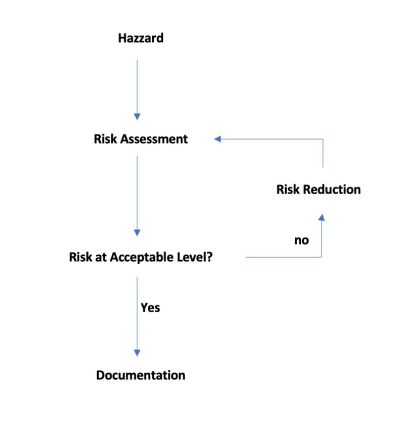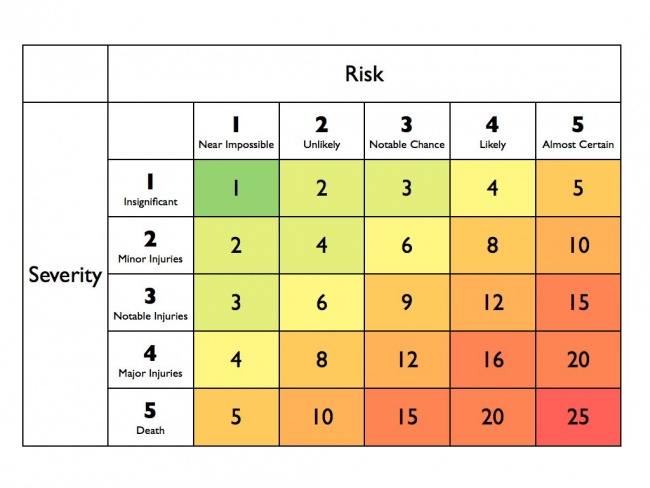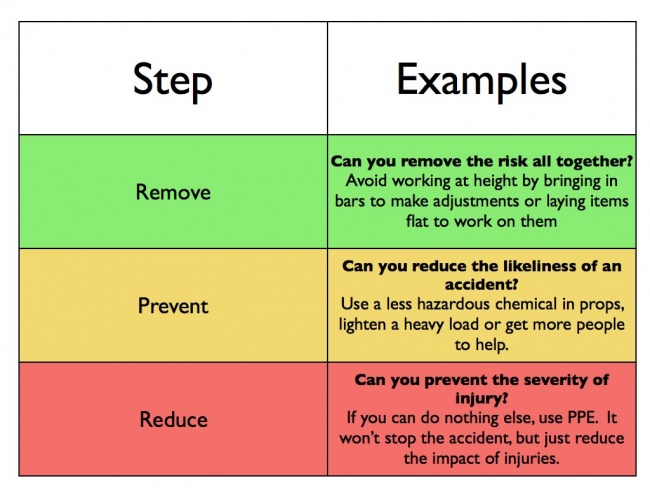Risk Assessments
Introduction
Completing a risk assessment is not as scary or complicated as many people think. In it's most basic form, it is a way of recording the simple and logical steps you and others take to ensure your safety. By putting this information in a form, it allows companies and organisations to ensure that everyone is following the same steps.
Companies will often do their risk assessments in slightly different formats, although most of them will share the same basic information.
I designed this simple flowchart for the ABTT to illustrate the simplicity of the process

The Process
Generic Risk Assessments and Blank Risk Assessment can be found on Teams under Production Health and Safety > Information Templates and Forms
1 - Look for a significant hazards. These might include slip and trip hazards, person falling/falling object hazards, different level platforms, electricity or water.
2 - Think about who might be harmed by this. Consider their role (for example: performer, staff, audience/visitor) and the number of people affected by one incident (one person/few people/many people).
3 - Assign a Likeliness Rating and a Severity Rating factoring in any current precautions. At RCS we use a scale of 1 to 5 where 1 equals near impossible or insignificant injuries and 5 equals a near certain accident or death. Calculate a Risk Factor by multiplying the Likeliness and Severity ratings. Look at the matrix below for an indication of how this scale works.
4 - Consider the current precautions, and decide on any new precautions required. When deciding on new precautions, always refer to the Hierarchy and use preventative methods (which will reduce the likeliness of an accident), before using protective measures (which will only reduce the severity of the injury).
5 - Sign off the Risk Assessment and make those changes.
The Risk Matrix
Hierarchy
Fact or Fiction
It is a legal requirement to do a risk assessment
Fiction (sort of). As an organisation or company it is a legal requirement to take precautions to reduce notable risks, to document this and be able to present it to the HSE if requested. It is not a legal requirement to perform a risk assessment, but is considered a world-wide standard. If you chose to manage risks in a different way you would need to justify why your method was the most appropriate. Recording risks in a theatre is a very different matter from recording risks in a shop. This is why there is not a universally accepted format for risk assessments.
You need to risk assess damage to property/equipment
Fiction (sort of). A risk assessment should be a document which explains the steps taken to prevent injury to people (and people only! Not things!). There are some cases where damaged equipment may cause additional risks to people around it (such as faulty electrical equipment may result in electrocution) so the risk assessment may include steps for appropriate storage and regular inspections. Steps to prevent an expensive prop being broken or damaging the venue should not be included in a risk assessment.
You can do anything if you risk assess it
Fact (sort of). Apart from breaking the law, you can do anything if you can risk assess it. You can dangle above a massive blender supported by dental floss tied to your toes if you can justify it is safe. While their are additional laws for the protection of children, this also applied to youth groups and schools. You can do anything if you can risk assess it (correctly).
You need to risk assess everything
Fiction. You only need to assess notable risks. There is no need to assess peoples’ legs falling off or aliens invading unless there are additional factors which make it more likely. Also, the Academy have many standard risk assessments for day-to-day tasks. As a student line-manager it is always worth asking to see these.
Risk Assessment Links by Department
The following are links to COSHH documents (that are updated every 2 years by a member of staff) categorized by department.
- RA & SSOW Scenic Art
- RA & SSOW Design
- RA & SSOW Scenic Construction
- RA & SSOW Costume
- RA & SSOW Props
Glossary
Preventive Measures Stops the accident from happening in the first place. Examples include fall restraint equipment, PAT testing equipment, using handrails and barriers etc. By using additional preventive measures, you will reduce the likeliness of an accident occurring.
Protective Measures Reduces the injury from an accident. An obvious example is most common PPE (hard hats, steel toe-capped boots, gloves, eye protection etc). Further examples include fall arrest equipment, reducing the height of a fall. By using additional protective measures, you will reduce the severity of an accident.
Collective Measures A measure in place to protect anyone placed in a situation. An example of a Collective Preventive measure would be blocking off a safe area under any work at height. An example of a Collective Protective measure would be installing a net under a drop.
Personal Measures A measure in place to protect individuals in a situation. An example of a Personal Preventative measure would be a fall restraint system or specialized training. An example of a Personal Protective measure would be PPE or a fall arrest system.
Fall Restraint System Prevents a fall. For example while working on a roof you may be attached to a lanyard which physically won’t let you reach the edge.
Fall Arrest System Reduces the effects of a fall. It will allow you to fall, but decelerate you and sometimes move you away from hazards. We have a fall arrest system installed in the Atheneum for FOH LX rigging.
Resources
HSE Website Click on 'Do a risk assessment' in the 'Getting started' box for further info from the HSE.

